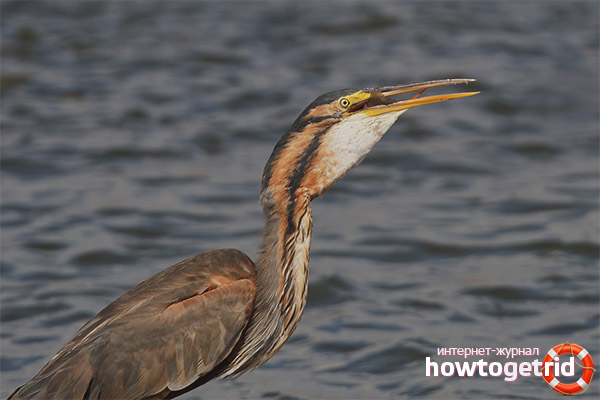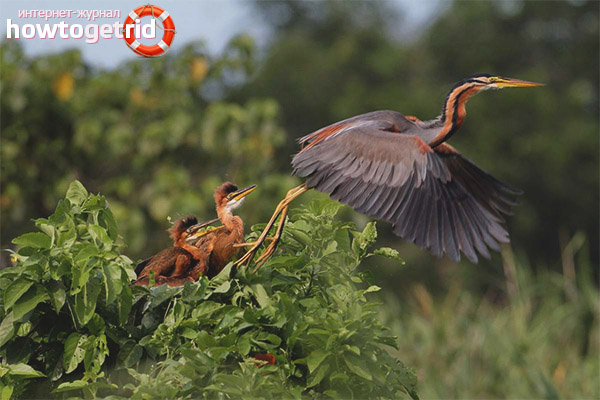The content of the article
All herons are remembered by people for their ability to stand on one leg in search of food or just resting. These beautiful representatives of the heron family have gained recognition for a long time, so today we are considering a red heron. It is distinguished by its hint of plumage, as the name implies. Despite the fact that the color of the bird is red with brownish splashes, if you translate its name from other languages, then literally it sounds like a purple heron.
View Features
Heron is found on wet flooded plains, near rivers, lakes, reservoirs. When the nesting period begins, the dwelling for future offspring is built on the basis of twigs. It is located on the trees. Birds prefer not to keep in large flocks, but in small groups.
A feature of birds is that they do not knock together in heaps. Individuals prefer to be located at a certain distance. When they nest, they occupy a large territory. Each group lasts 1-3 km. from the previous one.
If there are too many birds, they go together in search of a suitable place to build nests. There must be plenty of feed in this area. If there is no food, the older generation goes to get it.
Generally speaking, without affecting individual members of the family, herons live in marshy areas. Depending on the season, the swamp can be selected with fresh or brackish water. In winter, saline springs are usually preferred, and in summer fresh.
Description and habitat
Birds in their physique are slender and elongated. But, despite this, they are in the weight category 500-1400 gr. Agree, for large-sized birds these are small indicators. If we compare the red representatives of the family with their gray counterparts, the latter are slightly larger.
The side parts, back, tail have a gray plumage with a blue tone. On the chest and in the abdominal part, the feathers are red with a brownish undertones. When birds stand at sunset, they look bright red. But young growth is not famous for such plumage, it is rather brown with red blotches.
It makes sense to affect the number of these individuals. They live in Asia and Europe. They settle preferably not in the forest, in open places. But in areas with trees, they may also be in smaller numbers.
You can meet these birds on the Caspian, Black, Aral Sea. Herons were also seen in the Leningrad region. In the vastness of our homeland there are a lot of these individuals.
Nutrition
Individuals of this species obtain their food on small fry. They prefer to eat small fish, frogs, snake-like, as well as insects. Also used are mice and rats, small mammals.
An interesting feature is the hunting process itself. These birds do not pursue victims, they prefer to wait. They go deep into the water, squeeze one leg and stand motionless. It may take many hours before the bird feasts.
Hunting time is in the evening or early morning. Herons do not stand in packs, waiting for a meal. They diverge on different edges, preferring to get food alone. This is the effectiveness of this method of feeding.
The birds are so fast and strong that they can easily defeat large reptiles. Sharp claws, as well as long legs allow these individuals to step over the vegetation, following their goal.
Breeding
- As soon as the mating season begins in individuals, the color of birds increases significantly. In addition, long feathers located on the chest begin to stand out strongly at herons. When the courtship period begins, the birds whip their feathers around their neck and show beautiful gestures.
- Also during mating season, herons begin to build nests. At the same time they turn out to be quite impressive in size. As a building material, they use large leaves and large stems. Often the construction of the nest takes place in thick reeds.
- Dense bushes of ferns and mangroves are used as an alternative for these purposes. With rare exceptions, birds make homes in trees and in prickly bushes. The nest of the considered individuals has a conical shape. Over time, due to the chicks it becomes flat.
- At one time, the female is able to bring up to 5 eggs. In rare cases, the amount can reach up to 9 pieces. Eggs often have a bluish color with greens. In this case, the couple together is engaged in the construction of a nest, hatching offspring and feeding. Adults feed chicks burping foods.
- Only parents do not burp food for the chicks right in their beaks. Adults do this right in the nest. As soon as young growth is about 1.5 months old, they fly off the nest. Young herons extend their necks forward, in contrast to adults, in which it is presented in the form of the letter “S”.
- The presented herons are not peculiar far away from the nest. Such individuals continue to protect their site from relatives. At the same time, herons can occupy rather formidable poses. The individuals make strange puffing sounds, ruffling feathers. Chicks also try to defend their territory, they often and briefly shout.
Interesting Facts
Worldwide, officially there are more than 60 species of individuals represented. The smallest herons can grow up to 50 cm only. Large representatives of this species are up to 1.5 meters tall.
These birds live in different parts of the globe, with the exception of Antarctica and the circumpolar regions. Individuals of the presented family live in brackish and fresh springs, as well as in marshy areas and in reed beds.











Submit